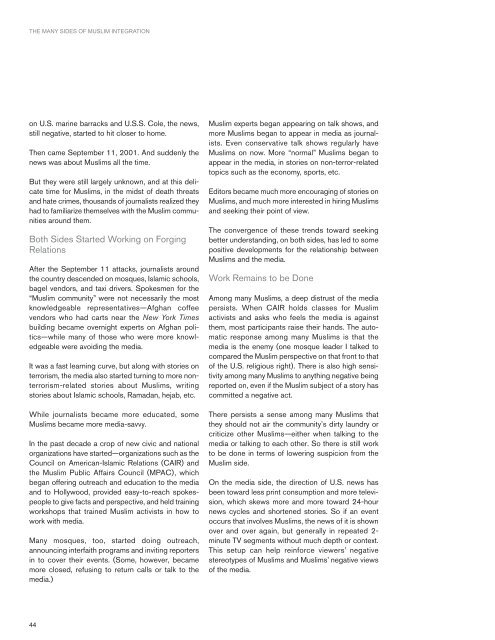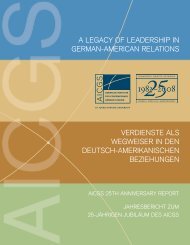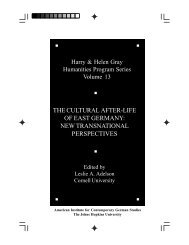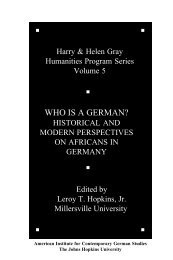the many sides of muslim integration: a german- american - aicgs
the many sides of muslim integration: a german- american - aicgs
the many sides of muslim integration: a german- american - aicgs
Create successful ePaper yourself
Turn your PDF publications into a flip-book with our unique Google optimized e-Paper software.
<strong>the</strong> <strong>many</strong> <strong>sides</strong> <strong>of</strong> <strong>muslim</strong> <strong>integration</strong><br />
on U.S. marine barracks and U.S.S. Cole, <strong>the</strong> news,<br />
still negative, started to hit closer to home.<br />
Then came September 11, 2001. And suddenly <strong>the</strong><br />
news was about Muslims all <strong>the</strong> time.<br />
But <strong>the</strong>y were still largely unknown, and at this delicate<br />
time for Muslims, in <strong>the</strong> midst <strong>of</strong> death threats<br />
and hate crimes, thousands <strong>of</strong> journalists realized <strong>the</strong>y<br />
had to familiarize <strong>the</strong>mselves with <strong>the</strong> Muslim communities<br />
around <strong>the</strong>m.<br />
Both Sides Started Working on Forging<br />
Relations<br />
After <strong>the</strong> September 11 attacks, journalists around<br />
<strong>the</strong> country descended on mosques, Islamic schools,<br />
bagel vendors, and taxi drivers. Spokesmen for <strong>the</strong><br />
“Muslim community” were not necessarily <strong>the</strong> most<br />
knowledgeable representatives—Afghan c<strong>of</strong>fee<br />
vendors who had carts near <strong>the</strong> New York Times<br />
building became overnight experts on Afghan politics—while<br />
<strong>many</strong> <strong>of</strong> those who were more knowledgeable<br />
were avoiding <strong>the</strong> media.<br />
It was a fast learning curve, but along with stories on<br />
terrorism, <strong>the</strong> media also started turning to more nonterrorism-related<br />
stories about Muslims, writing<br />
stories about Islamic schools, Ramadan, hejab, etc.<br />
While journalists became more educated, some<br />
Muslims became more media-savvy.<br />
In <strong>the</strong> past decade a crop <strong>of</strong> new civic and national<br />
organizations have started—organizations such as <strong>the</strong><br />
Council on American-Islamic Relations (CAIR) and<br />
<strong>the</strong> Muslim Public Affairs Council (MPAC), which<br />
began <strong>of</strong>fering outreach and education to <strong>the</strong> media<br />
and to Hollywood, provided easy-to-reach spokespeople<br />
to give facts and perspective, and held training<br />
workshops that trained Muslim activists in how to<br />
work with media.<br />
Many mosques, too, started doing outreach,<br />
announcing interfaith programs and inviting reporters<br />
in to cover <strong>the</strong>ir events. (Some, however, became<br />
more closed, refusing to return calls or talk to <strong>the</strong><br />
media.)<br />
44<br />
Muslim experts began appearing on talk shows, and<br />
more Muslims began to appear in media as journalists.<br />
Even conservative talk shows regularly have<br />
Muslims on now. More “normal” Muslims began to<br />
appear in <strong>the</strong> media, in stories on non-terror-related<br />
topics such as <strong>the</strong> economy, sports, etc.<br />
Editors became much more encouraging <strong>of</strong> stories on<br />
Muslims, and much more interested in hiring Muslims<br />
and seeking <strong>the</strong>ir point <strong>of</strong> view.<br />
The convergence <strong>of</strong> <strong>the</strong>se trends toward seeking<br />
better understanding, on both <strong>sides</strong>, has led to some<br />
positive developments for <strong>the</strong> relationship between<br />
Muslims and <strong>the</strong> media.<br />
Work Remains to be Done<br />
Among <strong>many</strong> Muslims, a deep distrust <strong>of</strong> <strong>the</strong> media<br />
persists. When CAIR holds classes for Muslim<br />
activists and asks who feels <strong>the</strong> media is against<br />
<strong>the</strong>m, most participants raise <strong>the</strong>ir hands. The automatic<br />
response among <strong>many</strong> Muslims is that <strong>the</strong><br />
media is <strong>the</strong> enemy (one mosque leader I talked to<br />
compared <strong>the</strong> Muslim perspective on that front to that<br />
<strong>of</strong> <strong>the</strong> U.S. religious right). There is also high sensitivity<br />
among <strong>many</strong> Muslims to anything negative being<br />
reported on, even if <strong>the</strong> Muslim subject <strong>of</strong> a story has<br />
committed a negative act.<br />
There persists a sense among <strong>many</strong> Muslims that<br />
<strong>the</strong>y should not air <strong>the</strong> community’s dirty laundry or<br />
criticize o<strong>the</strong>r Muslims—ei<strong>the</strong>r when talking to <strong>the</strong><br />
media or talking to each o<strong>the</strong>r. So <strong>the</strong>re is still work<br />
to be done in terms <strong>of</strong> lowering suspicion from <strong>the</strong><br />
Muslim side.<br />
On <strong>the</strong> media side, <strong>the</strong> direction <strong>of</strong> U.S. news has<br />
been toward less print consumption and more television,<br />
which skews more and more toward 24-hour<br />
news cycles and shortened stories. So if an event<br />
occurs that involves Muslims, <strong>the</strong> news <strong>of</strong> it is shown<br />
over and over again, but generally in repeated 2minute<br />
TV segments without much depth or context.<br />
This setup can help reinforce viewers’ negative<br />
stereotypes <strong>of</strong> Muslims and Muslims’ negative views<br />
<strong>of</strong> <strong>the</strong> media.





